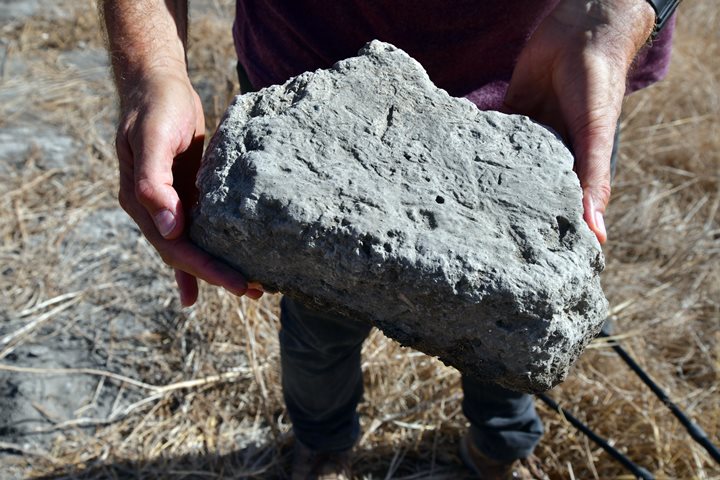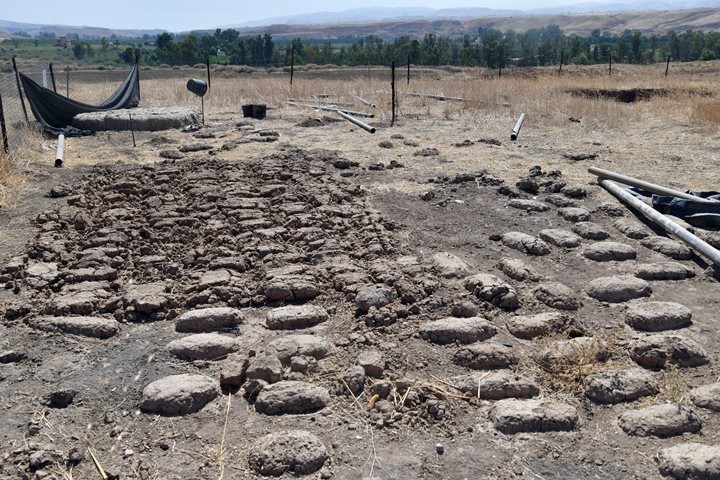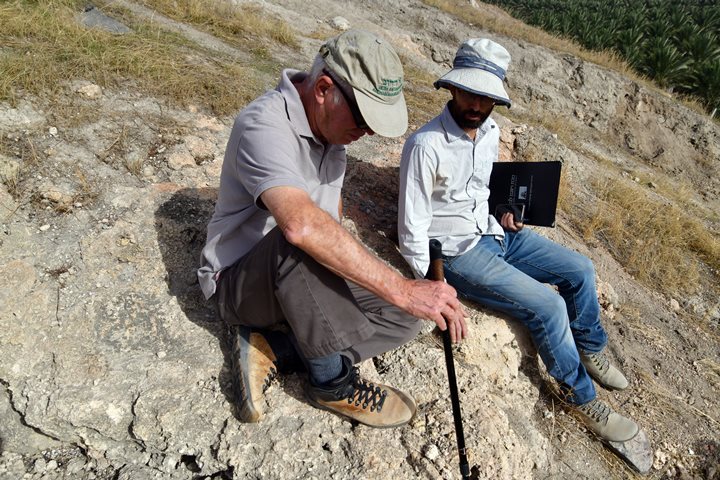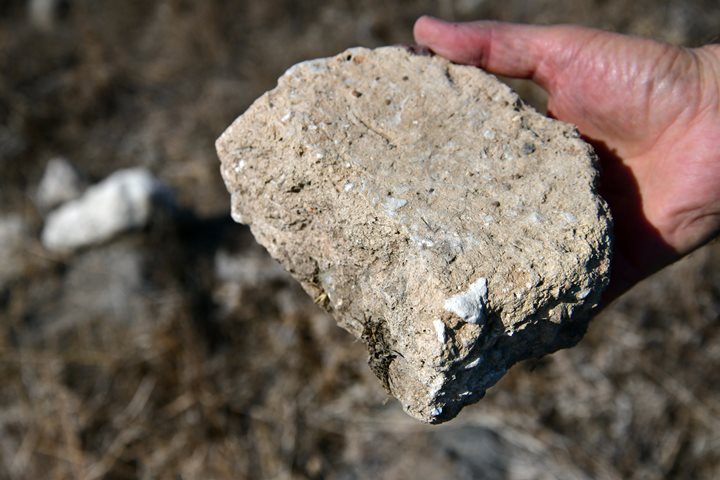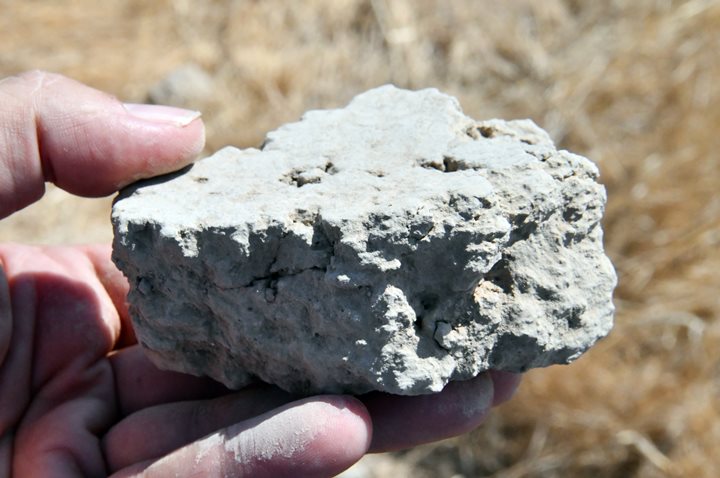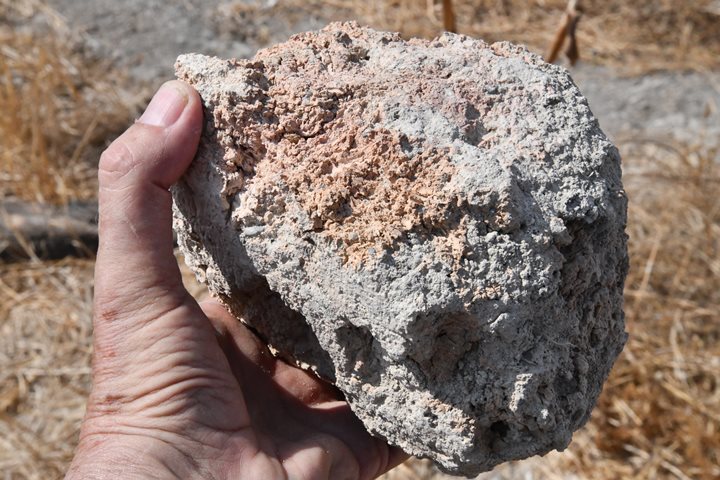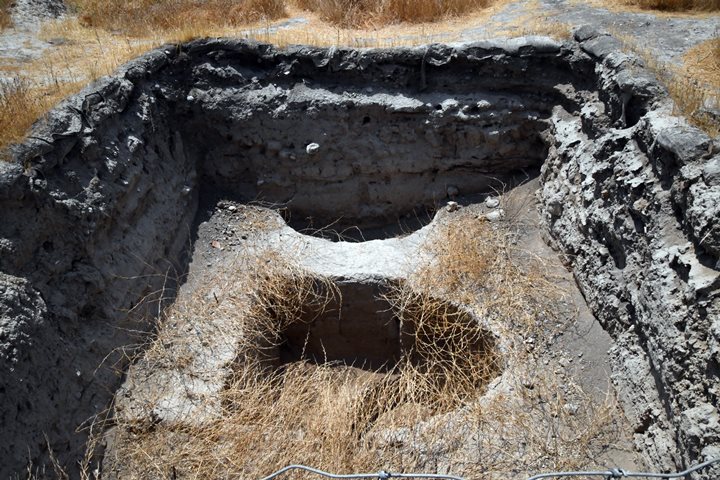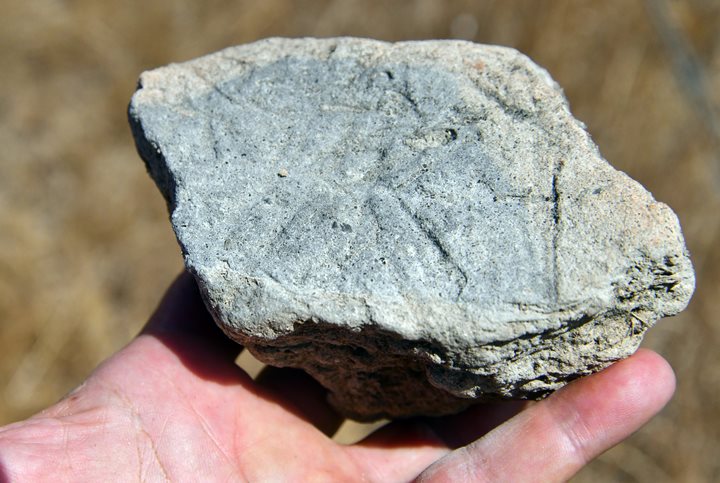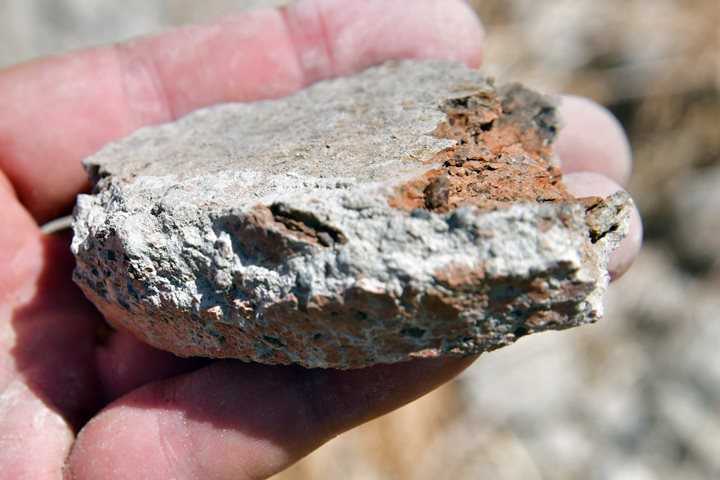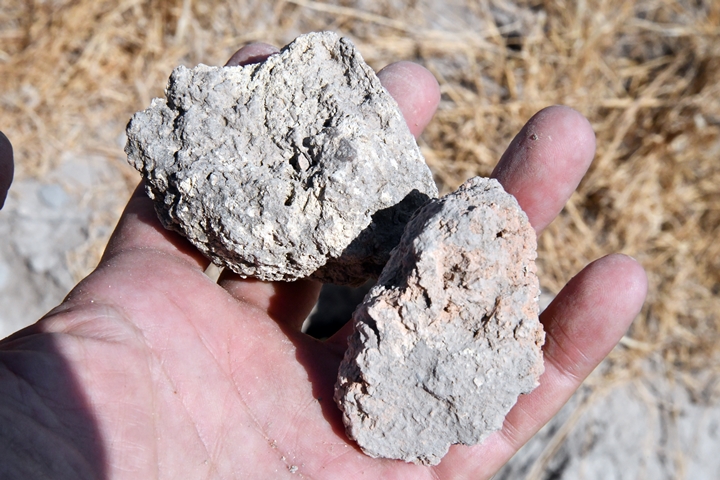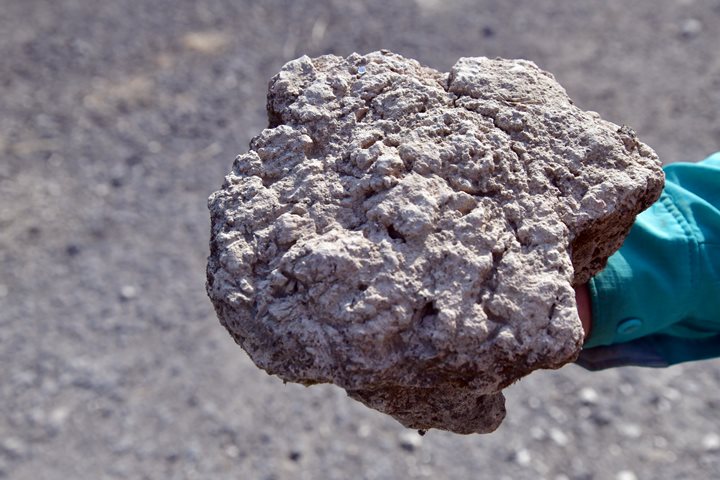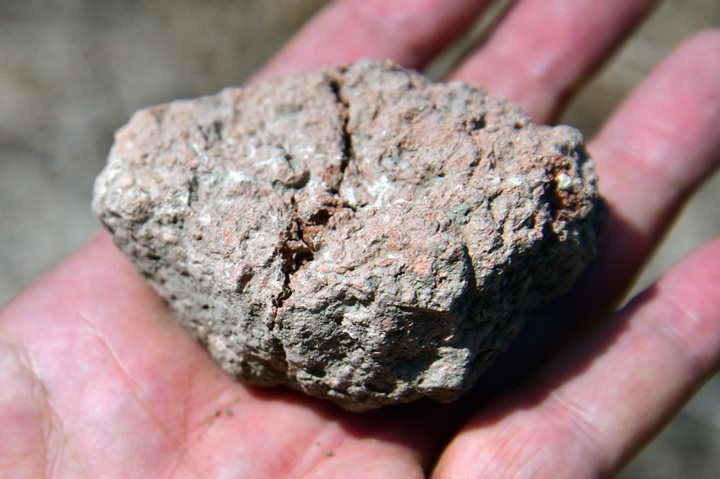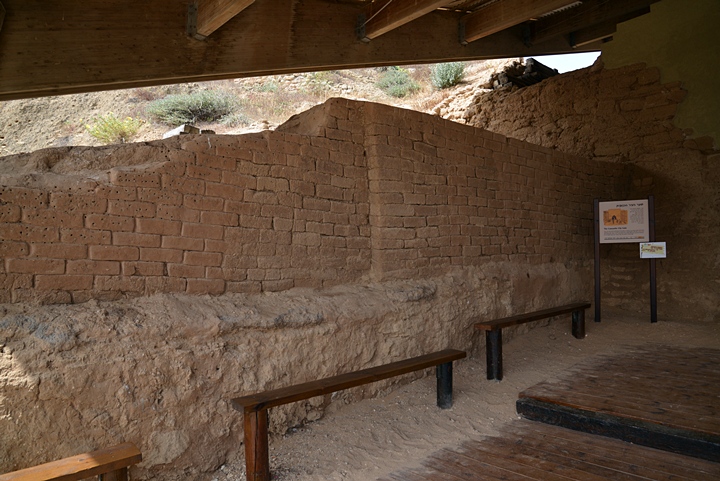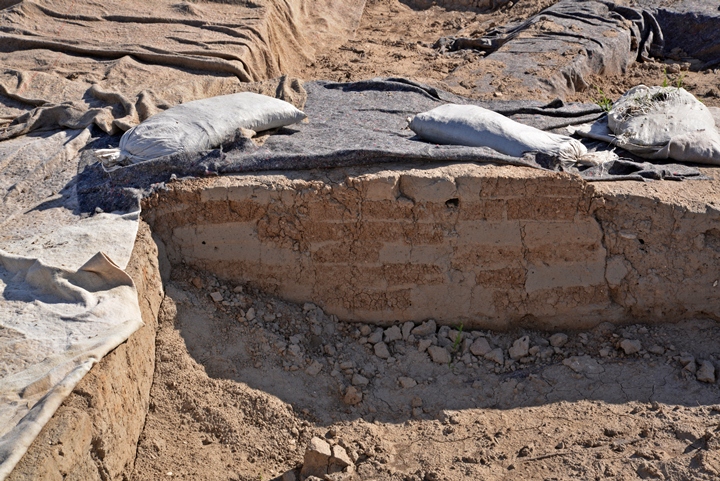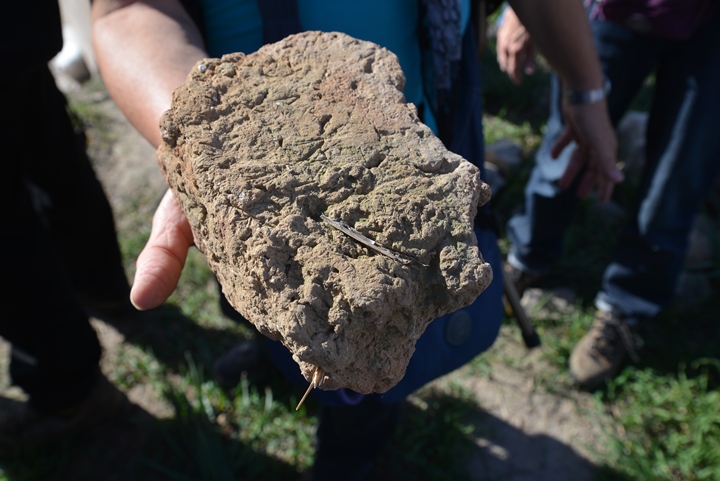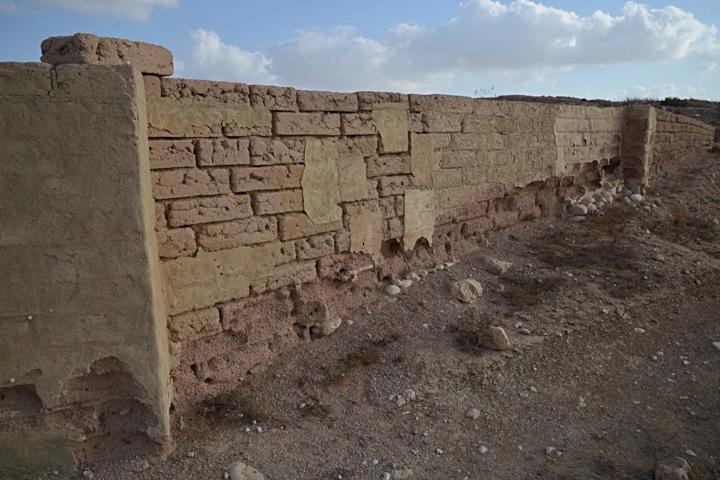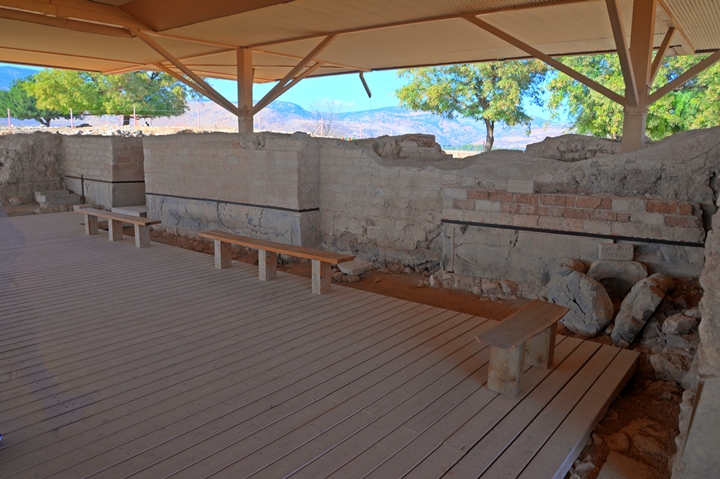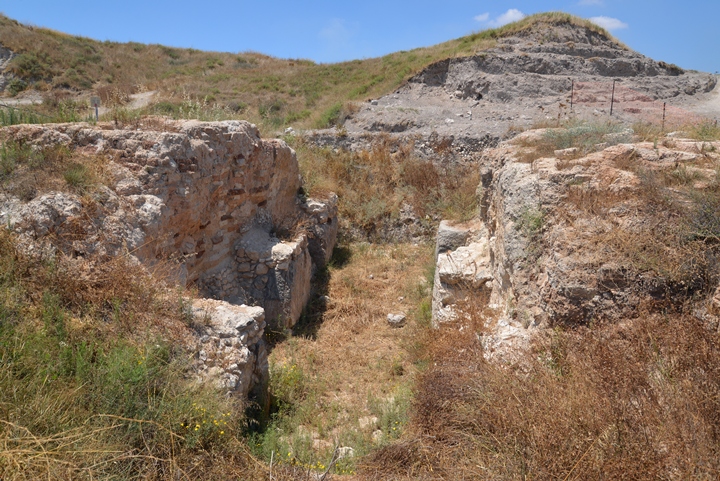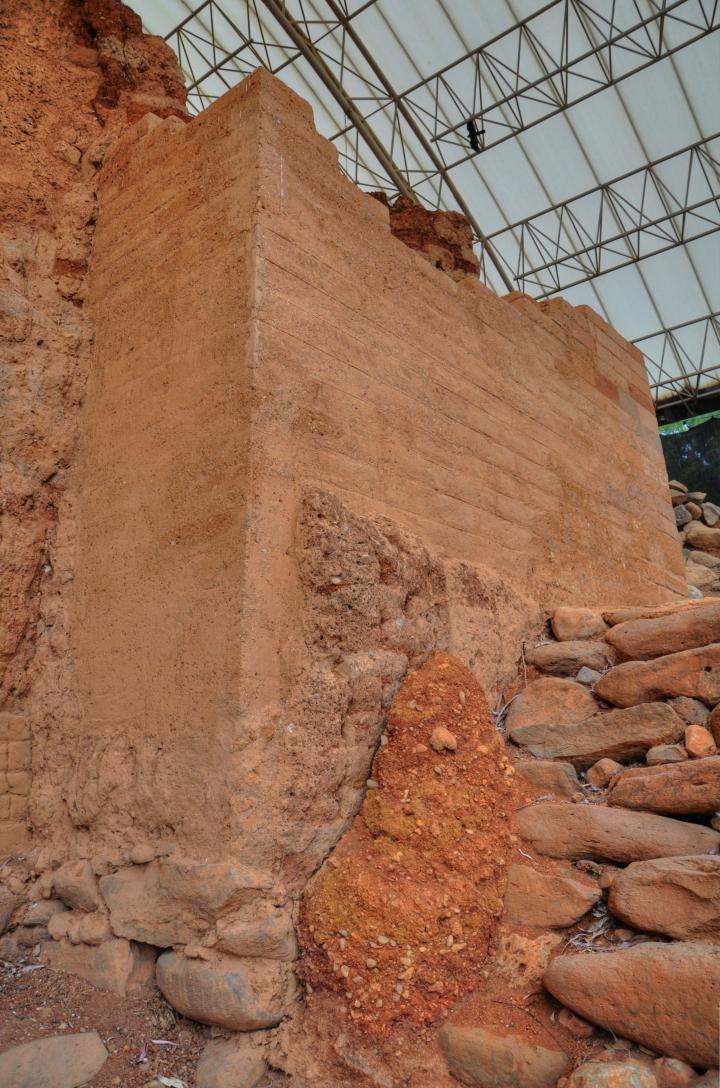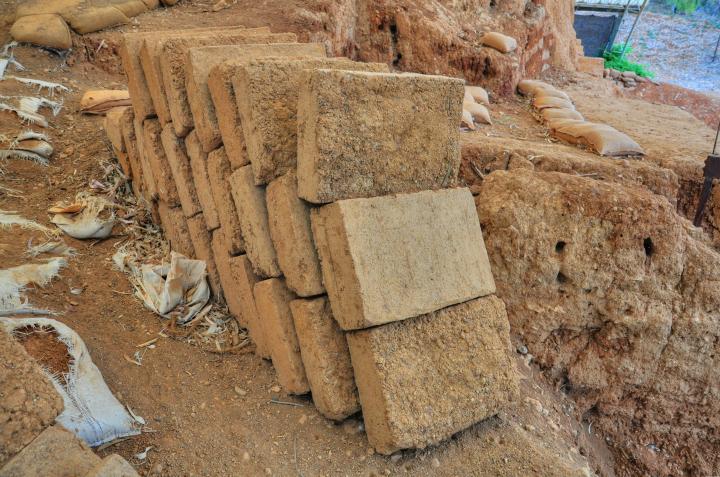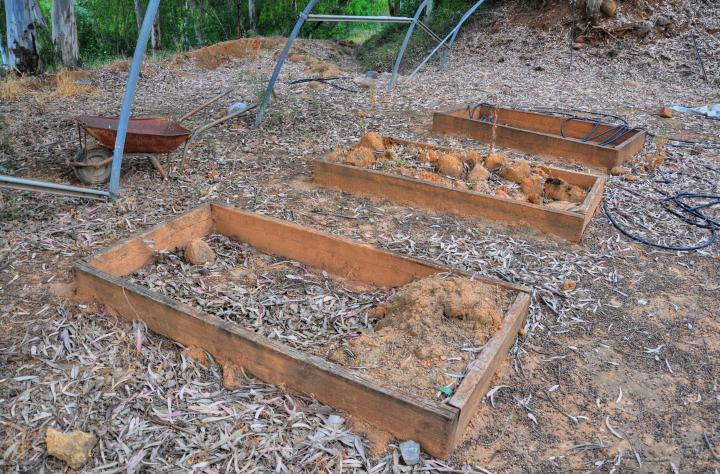An overview of sun-dried mud bricks used in ancient sites.
Contents:
* Background
* History
* Making mud bricks
* Why sun bake?
* Dating destruction
* Kiln vs Sun
* Biblewalks sites of mud bricks
* Etymology
* Biblical
* Links
Background:
Sun-dried mud bricks, also known as adobe, have a long history of use in construction in the ancient Near East, including the region that is modern-day Israel. These bricks were a fundamental building material during the Bronze and Iron Ages, playing a significant role in the architecture of ancient civilizations.
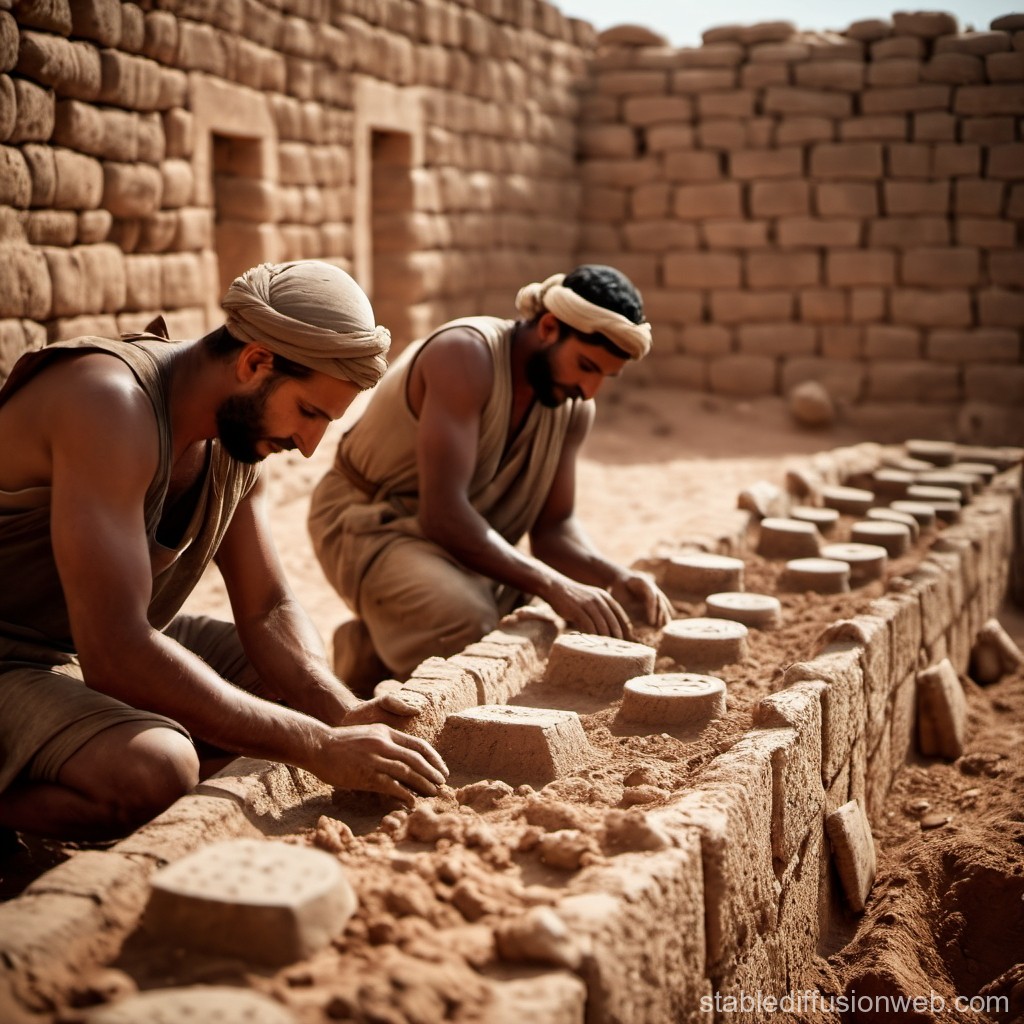
Artists working on a wall with mud bricks – AI generated by Stable Diffusion
History of Sun-Dried Mud Bricks in Israel
Sun-dried mud bricks were a crucial building material in ancient Israel. They were used extensively due to their availability, ease of production, and suitability for the region’s climate. Despite their susceptibility to weathering, the combination of mud bricks with stone and wood allowed ancient builders to create durable and long-lasting structures that have provided invaluable insights into the architectural and societal practices of these ancient civilizations.
Here are some notes on the history of sun-dried mud bricks:
1. Neolithic period – First appearance of Mud Bricks:
The first mud bricks were produced during the Neolithic period, around 10,000 to 9,000 BCE. This era marked a significant shift in human societies from nomadic lifestyles to settled agricultural communities, facilitating the need for more permanent dwellings and storage facilities. The production of mud bricks allowed these early societies to construct durable and long-lasting structures.
Jericho (Tell es-Sultan, 9500 BC) is one of the earliest known sites where mud bricks were used extensively. Excavations have revealed walls and a tower built with mud bricks dating back to the Pre-Pottery Neolithic A (PPNA) period. The bricks from this period were often molded by hand and sun-dried, forming the foundations of one of the first known urban settlements.
2. Chalcolithic period (c. 4500 to 3500 BC):
Sun-dried mud bricks were widely used in construction. During this period, as settlements grew and construction techniques became more sophisticated, the use of wooden molds became more common. This period saw a greater emphasis on uniformity and efficiency in brick production.
3. Early Bronze Age (c. 3500–2000 BC):
-
- Early urban centers (such as Arad, Jericho, and Megiddo) used sun-dried mud bricks extensively for constructing houses, city walls, and other structures.
- Mud bricks were favored due to the abundance of clay and water, which were necessary for their production.
- The walls of these structures were often reinforced with wooden beams to provide additional stability.
4. Middle Bronze Age (c. 2000–1550 BC):
-
- Continued use of mud bricks in the construction of more sophisticated city fortifications and palatial structures.
- Notable sites include Hazor and Shechem, where extensive mud brick fortifications and large public buildings have been excavated.
- The introduction of new architectural techniques, such as buttresses and thicker walls, improved the durability and strength of mud brick constructions.
5. Late Bronze Age (c. 1550–1200 BC):
-
- Continued use of mud bricks, though there was an increase in the use of stone foundations to support the mud brick walls, particularly in more prominent buildings and temples.
- Sites like Lachish and Megiddo provide evidence of extensive use of mud bricks in both domestic and public architecture.
6. Iron Age I (c. 1200–1000 BC):
-
- Mud brick construction remained prevalent, with significant sites like Tel Dan and Beersheba showing extensive use of this material.
- Fortifications and city walls continued to be built with sun-dried mud bricks, often combined with stone elements.
7. Iron Age II (c. 1000–586 BC):
-
- The Kingdoms of Israel and Judah saw extensive urban development, with cities like Jerusalem, Samaria, and Lachish expanding significantly.
- Use of mud bricks persisted, though there was a noticeable increase in the use of stone, particularly in more affluent constructions and public buildings.
- Large-scale constructions, such as the expansion of Jerusalem under King Hezekiah, utilized a combination of stone and mud brick materials.
Archaeological Evidence
- Tel Megiddo: Known for its extensive Bronze and Iron Age remains, Megiddo’s mud brick constructions include city walls, gates, and residential buildings.
- Tel Hazor: Excavations have revealed massive mud brick walls and public buildings from the Middle and Late Bronze Age.
- Jericho: One of the earliest known sites with extensive use of mud bricks, including the famous Neolithic tower and later Bronze Age fortifications.
- Beersheba: Provides evidence of mud brick construction, Chalcolithic thru the Iron Age periods, particularly in domestic architecture.
Use and Construction Techniques
Production:
- Materials: Mud bricks were made from a mixture of clay, water, and organic materials such as straw or chaff. This mixture was then molded into brick shapes and left to dry in the sun .
- Molding: Bricks were typically molded in rectangular wooden frames and left to dry for several days or weeks, depending on the climate.
- Drying: The sun-drying process made the bricks hard and durable, though not as strong as fired bricks.
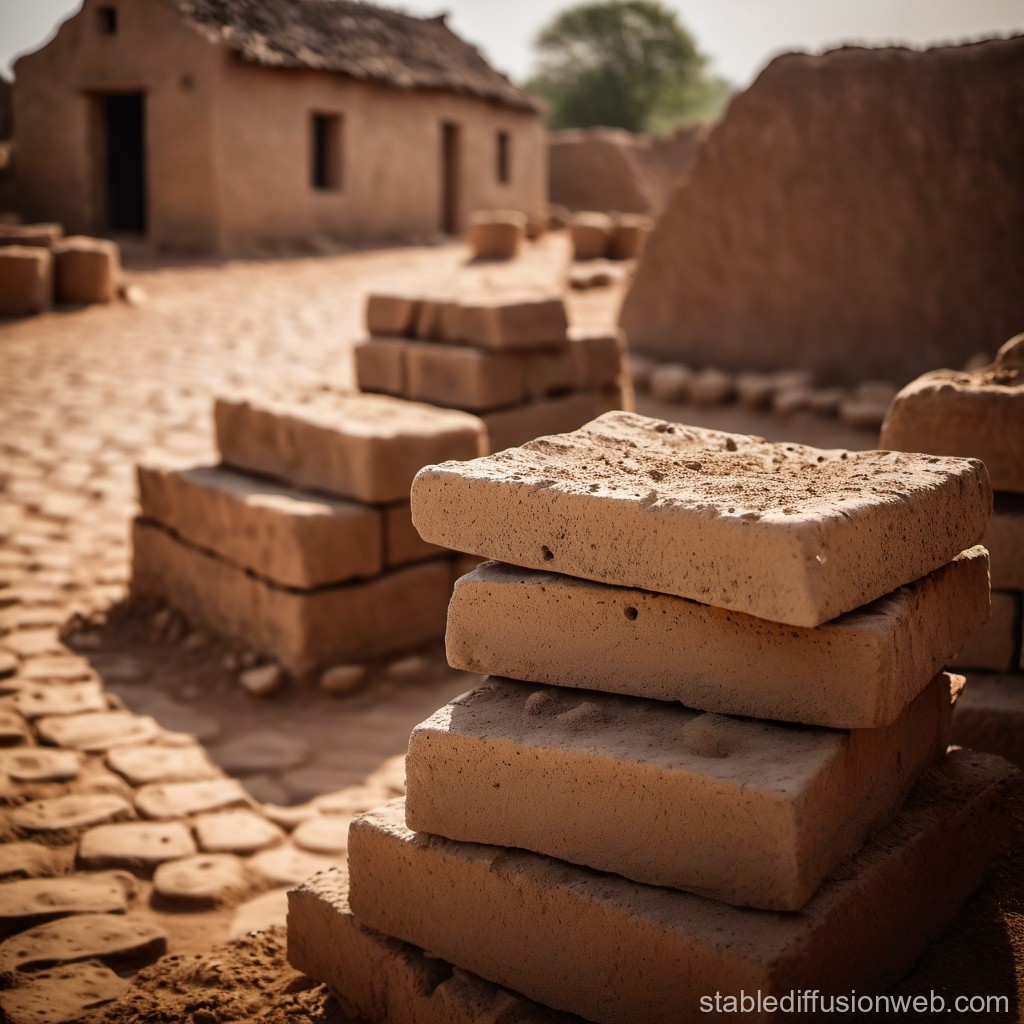
Sun dried mud bricks used for construction– AI generated by Stable Diffusion
Construction:
- Wall Construction: Mud bricks were laid in rows with a mortar of wet mud used to bind them together. Walls were often thick to provide stability and insulation.
- Reinforcement: Wooden beams and stone foundations were used to reinforce structures, providing additional stability and protection against weathering.
- Plastering: Mud brick walls were often coated with plaster to protect them from rain and erosion. Lime plaster was commonly used, especially in later periods.
Why Bake the mud bricks in the sun?
During the Iron Age in Israel, sun-dried mud bricks were preferred over kiln-fired bricks for several practical and economic reasons:
1. Resource Availability
- Abundance of Materials: The primary materials needed for sun-dried bricks—clay, water, and straw—were readily available in many regions of Israel. This made the production process straightforward and resource-efficient.
- Fuel Scarcity: Kiln-firing bricks require significant amounts of fuel, such as wood or charcoal. In many parts of ancient Israel, wood was a valuable and sometimes scarce resource, making it impractical to use large quantities for brick firing.
2. Economic Considerations
- Cost Efficiency: Producing sun-dried mud bricks was much cheaper than firing bricks in a kiln. The process required less labor, less fuel, and simpler technology.
- Labor and Time: Sun-drying bricks requires minimal labor after the initial preparation and molding. In contrast, firing bricks involves continuous labor to maintain the kiln’s temperature and manage the firing process, which also takes more time.
3. Climatic Conditions
- Favorable Climate: The climate in much of Israel, particularly in the summer months, is hot and dry, ideal for the sun-drying process. This natural environment made it efficient to produce durable sun-dried bricks without the need for artificial heating.
- Seasonal Drying: The prolonged dry seasons allowed for the production and storage of large quantities of sun-dried bricks, ensuring a steady supply for construction needs.
4. Structural Adequacy
- Sufficient Durability: For many types of structures, especially residential buildings, sun-dried mud bricks provided sufficient durability and insulation. While not as strong as kiln-fired bricks, they were adequate for the architectural requirements of the time.
- Architectural Techniques: Builders used various methods to enhance the durability of mud brick structures, such as thick walls, wooden beam reinforcements, and protective plaster coatings. Stone foundations and buttresses were also used to improve stability and longevity.
5. Tradition and Expertise
- Established Practice: The use of sun-dried mud bricks had a long tradition in the region, dating back to earlier periods. Builders had extensive knowledge and experience in working with this material, making it a trusted and familiar choice.
- Cultural Continuity: The continuity of building practices facilitated the transfer of skills and techniques across generations, ensuring the effective use of sun-dried bricks in construction.
Archaeological Evidence
- Widespread Use: Excavations at Iron Age sites like Tel Megiddo, Tel Dan, and Beersheba show extensive use of sun-dried mud bricks in residential, public, and fortification structures.
- Adaptive Methods: Evidence of adaptive construction techniques, such as the use of stone and wood reinforcements alongside mud bricks, demonstrates the ingenuity of ancient builders in maximizing the effectiveness of their available materials.
Case study: The excavation team of the Neolithic village of Tel Tsaf researched the method of producing the sun baked mud bricks. In an area close to the excavation squares they performed experiments. In this early settlement the bricks were often molded by hand.
Conclusion: The preference for sun-dried mud bricks in Iron Age Israel was driven by a combination of resource availability, economic considerations, favorable climatic conditions, sufficient structural adequacy, and established construction practices. These factors made sun-dried bricks a practical and efficient choice for building in the region during this period.
Dating by analyzing burnt mud bricks:
Sun dried mud bricks can be analyzed by a method based on the magnetic properties of burnt mud bricks (paleomagnetism) to date their time of being on fire following the destruction of the city. This new technology will help to determine the destruction time of the site, supplementing other dating techniques such as ceramic dating and Radio-Carbon (C-14) dating. The technique measures the direction of the earth’s magnetic field recorded in a burnt sun dried mud brick and compares it to the historic magnetic field variations.
Principle:
High Temperature Exposure: When the mud bricks are heated to high temperatures, typically above the Curie temperature (the temperature at which certain magnetic materials lose their permanent magnetic properties), the magnetic domains within the minerals become disordered.
Cooling Below Curie Temperature: As the bricks begin to cool down and drop below their Curie temperature, the magnetic minerals within them start to regain their magnetic properties. The Curie temperature varies depending on the specific mineral (e.g., magnetite has a Curie temperature of about 580°C).
Alignment with Earth’s Magnetic Field: During cooling, the magnetic minerals align with the Earth’s magnetic field. This alignment occurs because the magnetic domains within the minerals become locked into a configuration that is parallel to the external magnetic field at that time.
Acquisition of Thermoremanent Magnetization (TRM): Once the bricks cool completely, the aligned magnetic domains are “frozen” in place, retaining a thermoremanent magnetization. This TRM reflects the direction and intensity of the Earth’s magnetic field at the time when the bricks cooled past the Curie temperature.
After Cooling: The acquired TRM is stable over long periods of time, provided the bricks are not reheated above the Curie temperature again. This makes TRM a reliable record of the Earth’s past magnetic field. The TRM is locked into the bricks’ magnetic minerals and can be preserved for thousands to millions of years. Even brush fires would not unlock the acquired TRM as the heat does not exceed the curie temperature.
Implications for Paleomagnetic Studies:
- By analyzing the TRM in the bricks, scientists can determine the direction and intensity of the Earth’s magnetic field at the time of the last heating event. This information can then be matched with known changes in the Earth’s magnetic field over time to date the event.
- This technique is particularly useful in archaeology for dating events such as the destruction of cities by fire, as it provides a way to precisely date the last time the bricks were subjected to high temperatures.
Limitations and Considerations
- Accuracy and Calibration: The accuracy of archaeomagnetic dating depends on the availability of well-dated reference curves for the geomagnetic field. In regions where such curves are incomplete or less precise, the reliability of archaeomagnetic dates can be affected.
- Interdisciplinary Collaboration: Archaeomagnetism works best when used in conjunction with other dating methods (e.g., radiocarbon dating, dendrochronology) and historical research. Interdisciplinary collaboration enhances the robustness of the conclusions drawn from archaeomagnetic studies.
Case studies: In Israel, paleomagnetic studies have been used to date destruction layers at sites like:
- Lachish: The burnt mud bricks from the destruction layer attributed to the Babylonian conquest have been analyzed to determine the magnetic alignment. This helps to cross-check historical and archaeological dates with geomagnetic data.
- Megiddo: Similar analyses on destruction layers provide data that contribute to the broader understanding of the timing of various destruction events recorded in historical texts and other archaeological evidence.
- Tel Nissa: Doctor Yoav Vaknin specializes on archaeomagnetic dating of mud bricks. A new excavation was conducted in 2024 to determine when was the Iron Age city burnt (one of the 3 Iron Age destructions reported by the Bible – 924 BC by Shishak of Egypt, 815-810 BC by Hazael of Aram-Damascus, 732 BC by Tiglat Pileser III of Assyria).
Below – Prof. Mazar and Dr. Vaknin examine a section of the exposed south-eastern wall on Tel Nissa, just below the summit. This wall is made of hardened mud bricks that have been exposed to destruction fire.
Summary: Paleomagnetism is a valuable tool in the archaeological toolkit, offering a method to date past events based on the Earth’s magnetic field record. When applied to burnt mud bricks and other fired materials, it provides critical insights into the timing of ancient destruction events, enhancing our understanding of historical and prehistorical chronologies, and assisting Biblical research.
Kiln-Fired versus Sun-dried Bricks :
Mud Bricks in Biblewalks sites:
Most of the Bronze/Iron age sites that are reviewed are built with sun dried mud bricks. Here is a sample of ancient sites with sun-dried mud bricks:
(a) Jordan valley area
The Jordan Valley’s preference for sun-dried mud bricks was influenced by the region’s favorable climate, the availability of necessary materials, economic considerations, technological simplicity, traditional practices, and the thermal efficiency of these bricks. These factors combined to make sun-dried mud bricks a practical and sustainable choice for construction in the region.
An artificial mound located in the Beit She’an valley, with remains from the Canaanite and Israelite periods. Hundreds of thousands of sun-dried mud bricks were used to build the city walls and houses.
Ancient sites near the valley around ‘Ein Shakhal spring in the Nahal Tabor valley. The majority of sites around ‘Ein Shakhal are of the Early Bronze period.
Tel Eshtori (Tell el Maliha or Malhah) is a small mound on the south side of the modern road from Beit Shean to the border pass at Sheikh Hussein. Ceramics collected on Tel Eshtori were dated to the Early Bronze, Middle Bronze II, Late Bronze, Iron I, Iron II, and Persian.
Tel Zofim, a site west of Sheikh Hussein, is located on a high steep hill overlooking the Jordan river crossing. Many sun dried mud bricks were seen on the summit of mound. The orange tan seen on the surface of this brick, as well as others seen on the southern side of the summit, may indicate that the mud brick was subjected to intense fire as a result of conquest. Dr. Yoav Vaknin, a Paleomagnetism expert, confirmed that the sun-dried mud bricks was indeed subjected to heat, and therefore could be used for dating the destruction.
Tel Malqet (Tell Mollikat) is a Bronze/Iron age site in the Jordan valley, on the route from Rechov to the Jordan river crossings. Its ruins are spread on a low hill and on the area east and south of the hill.
Tel Zemed is an ancient site in the Jordan valley, en route from Beit Shean to the Transjordan city of Jabesh Gilead.
Tel Tsaf is a large Late Neolithic site, dating back to around 5,500 to 4,500 BCE, making it over 7,000 years old.
The walls are built of sun dried mud bricks. A line of the bricks can be seen in the back wall. The walls were coated with plaster, and the structure had a beaten earth floor.
This is one of the bricks we saw on the ground.
An artificial mound located in the central Jordan valley, that guarded a major crossing point of the Jordan river.
At Tel Issachar are ruins of an ancient Canaanite and Israelite city, located on a mound on the north bank of Issachar brook.
Remains of some of the mud bricks is shown here. Most of the bricks have since crumbled into dust, but some parts are still found along the slopes.
Watch a short video of a sun dried mudbrick that was found on the site.
Tel Kittan (Tell Abu Musa, Tell Sheikh Qassim) is located to the south of Nahal Tabor stream, with remains of Chalcolithic and Bronze periods.
This mud brick was found in the Bronze/Iron Age settlement north of ‘Ain Ed-Deir.
(b) Other areas
Sun-dried mud bricks were also widely used in other parts of the Levant. Here are sample sites with mud bricks that we encountered during our visits.
Tel Yifar, a nature reserve near Moshav Balfouria in the Jezreel valley, was a Biblical site located near ancient crossroads.
A piece of a sun dried mud brick found on the top of the mound.
Ruins of a large Canaanite and Israelite city in the southern low hills of Judea. Among the ruins are sun dried mud bricks, which were used to raise the height of the walls
A mud bricked wall on the side of the Canaanite period city gate at the north side of Tel Ashkelon:
Ruins of a large multi-period Canaanite city, first fortified in the Early Bronze I period.
The walls are based on sun-dried mud bricks. In the following photo the bricks are noticeable by the different tones of color.
Here is an example of a brick found in this area.
A National park, with ruins of an Israelite Kingdom fortified administrative city, located between the Be’er Sheva (BeerSheba) and Hebron streams.
An Iron Age city casemate wall was built with sun dried mud bricks. The plaster on the wall protected the sun baked mud bricks from the effect of the water and wind.
The Canaanite palace was built with mud bricks, lined with huge black basalt sliced stones as a base, as can be seen in the photo below.
In Tel Gezer are ruins of a major Canaanite and Israelite fortified city. It was one of the famous Biblical cities, conquered by Joshua and fortified by King Solomon. The city gate, dated to the Middle Bronze age, is made of sun dried mud bricks, laid over a stone foundation. It was preserved to a height of 7 meters.
The Canaanite tower on the right side of the city gate is shown in detail below. Like all the elements of the gate, it is made by sun-baked bricks.
During the reconstruction of the gate, the archaeologists prepared similar bricks to fill in the missing segments.
These bricks were prepared using the ancient techniques of placing the mud into a mold, then baking it in the sun:
Etymology:
- Adobe – Spanish for mudbrick
- Adobe – a mixture of earth and straw, made into bricks and dried in the sun
- Mud Brick– In Hebrew: Livnei Botz
Biblical:
Mud bricks are mentioned in several passages in the Bible, reflecting their common use as a building material in ancient times, especially in the context of Israel and neighboring regions. Here are some notable references:
Exodus 1:14 and 5:6-19
In the book of Exodus, mud bricks are central to the narrative of the Israelites’ enslavement in Egypt:
- Exodus 1:14: “They made their lives bitter with hard service in mortar and bricks and in all kinds of work in the field. In all their work they ruthlessly made them work as slaves.”
- Exodus 5:6-19: This passage describes how the Pharaoh demanded the Israelites make bricks without providing straw, increasing their labor and suffering. Straw was a crucial component mixed with mud to strengthen the bricks.
Genesis 11:3
The story of the Tower of Babel mentions the use of bricks: “And they said to one another, ‘Come, let us make bricks and burn them thoroughly.’ And they had brick for stone, and bitumen for mortar.”
-
- This passage highlights the use of kiln-fired bricks, which contrasts with the more common sun-dried bricks.
- While sun-dried mud bricks were commonly used in Mesopotamia for everyday construction due to their low cost and ease of production, kiln-fired bricks were preferred for structures that required greater durability and strength.
Ezekiel 4:1
The prophet Ezekiel uses a brick in a symbolic act: “And you, son of man, take a brick and lay it before you, and engrave on it a city, even Jerusalem.”
-
- Here, a brick is used as a visual aid in a prophetic act to represent the city of Jerusalem.
Isaiah 9:10
The book of Isaiah contrasts bricks with other building materials: “The bricks have fallen, but we will build with dressed stones; the sycamores have been cut down, but we will put cedars in their place.”
-
- This passage reflects the use of bricks in construction and the intention to replace them with more durable materials, such as dressed stones, after destruction.
Links:
* Archaeomagnetic Dating of mud bricks:
- Archaeomagnetic Dating of mud bricks – TOI 2022
- Geomagnetic Field Data – Tau (Hebrew) – a scientific breakthrough dated 21 layers of destruction in 17 archaeological sites
- Archaeomagnetic Dating of the Outer Revetment Wall at Tel Lachish. Vaknin, Y., Shaar, R., Ben-Yosef, E., & Lipschits, O. (2024). Tel Aviv, 51(1), 73–94.
- “Reconstructing biblical military campaigns using geomagnetic field data“. Yoav Vaknin, Ron Shaar, Oded Lipschits, and Erez Ben-Yosef (2022). Proceedings of the National Academy of Sciences. 119 (44).
- Dating a sun dried mudbrick based on intensity.
* Make your own:
- How to make your own bricks? PeePal farm (YouTube, 3.51 minutes)
BibleWalks.com – walk with us through the sites of the Holy Land
Hiding Complexes<<<—Previous —<<< All Info >>>—Next Info—>>> Mosaics
This page was last updated on Jan 22, 2025 (add video)
Sponsored links:
